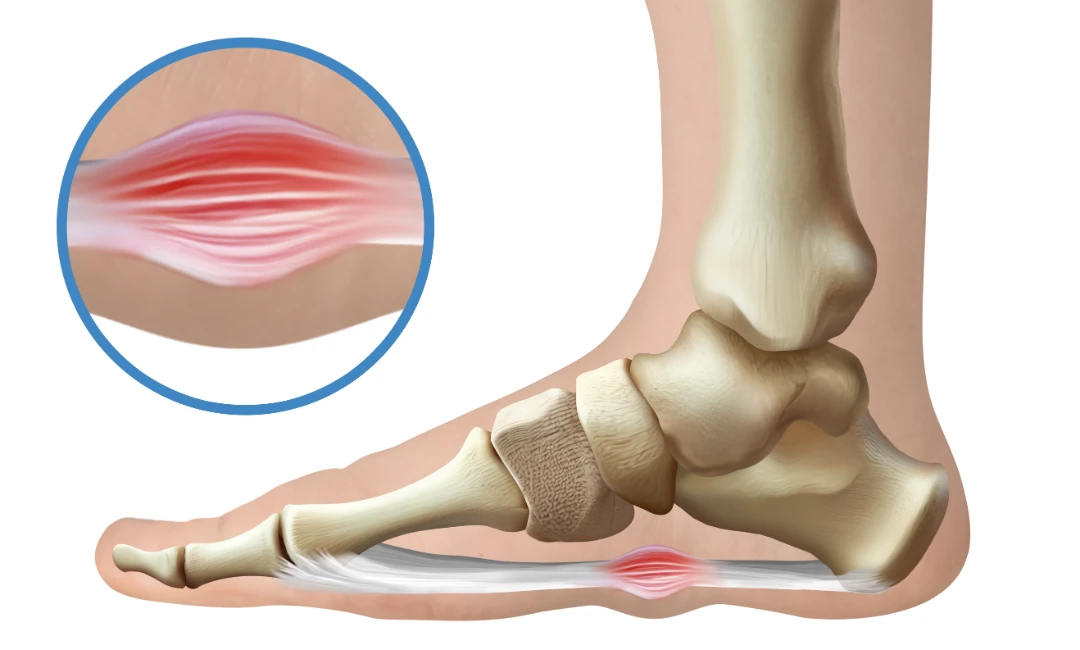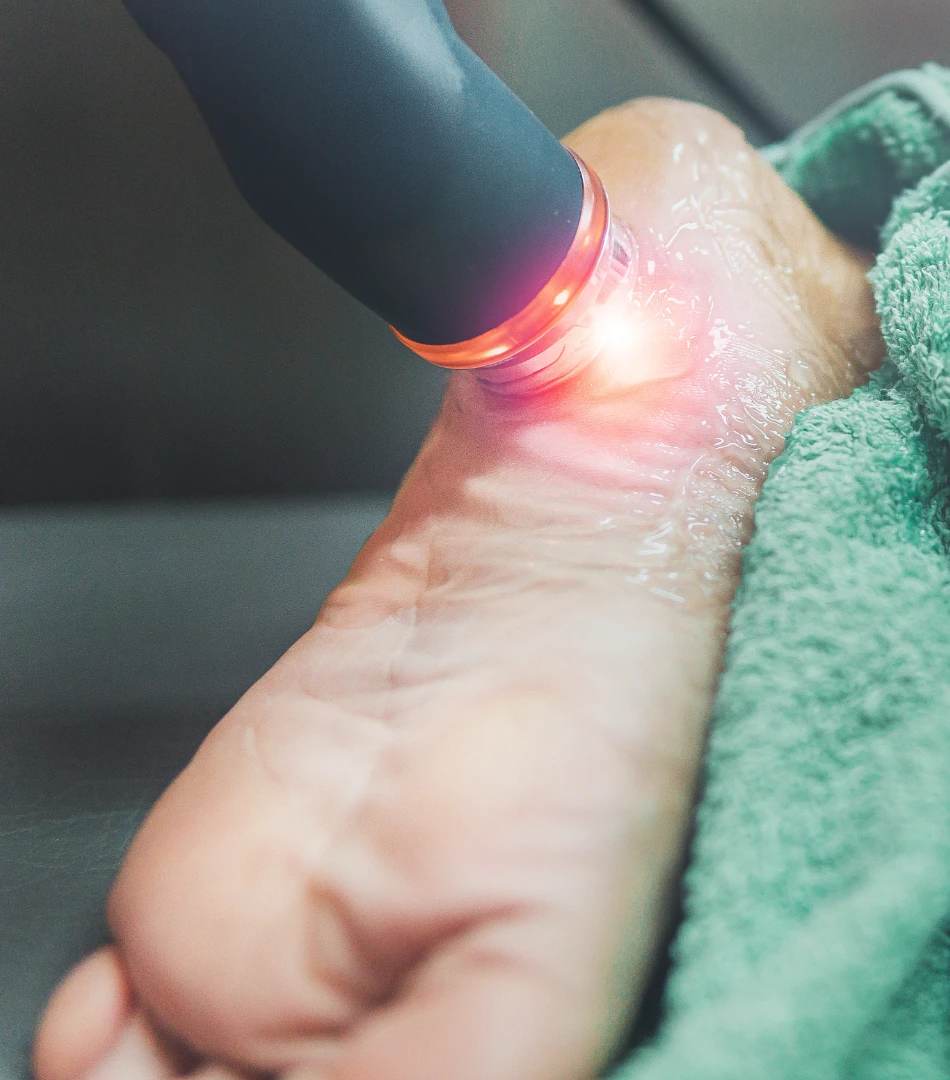Plantar
Fibroma
- Home
- Conditions We Treat
- Foot & Ankle
- Plantar Fibroma

What is
plantar fibroma?
Plantar fibroma is a rare, benign (non-cancerous) and slow-growing growth that develops on the ligament known as the plantar fascia. Plantar fascia stabilises the arch of the foot and is a rubber band-like ligament that extends from the heel to the toes.
The growth is typically less than an inch and grows on the arch of the foot on either one or both feet. Plantar fibroma often goes unnoticed, however, over time, it causes discomfort, especially when wearing shoes. If the growth enlarges, or multiple it may progress into a condition known as plantar fibromatosis (Ledderhose disease). Despite its symptoms, these growths are typically benign and carry a very low risk of becoming malignant (cancerous).
What causes plantar fibroma?
Medical professionals are unable to determine the exact causes of plantar fibroma, as well as plantar fibromatosis. Some experts believe that plantar fibroma begins with small tears in the plantar fascia tendon due to trauma or injuries. Consequently, these scar tissues then gradually form into a lump on the arch of the foot.
Who is at risk of plantar fibroma in Singapore?
Although plantar fibroma is a rare condition, there are certain groups of people who are more susceptible to developing these growths;
- Ancestry: you are more likely to develop plantar fibroma if you have a European ancestry, especially those with Northern Europe ancestry, compared to other ethnicities.
- Age: plantar fibroma is more common among those between 40, and 60 years old. However, younger individuals are not immune to the condition, as a study has found children as young as 9 months old may develop this growth.
- Family history: if you have a family history of plantar fibroma, then your chances of developing the condition are higher.
- Gender: men are more susceptible to developing plantar fibroma compared to women.
- Medical conditions: if you are diagnosed with chronic liver diseases, diabetes or epilepsy, then you have a higher likelihood of developing the condition.
- Plantar fascia injury: your chances of developing plantar fibroma are higher if you frequently sustain injuries to your plantar fascia tendon.

What are the symptoms of plantar fibroma?
Some of the possible symptoms of plantar fibroma include:
- A noticeabl, marble-like and firm lump on the arch of your foot.
- Small, painless lumps that are developed in the middle of your feet (in the early stages).
- Pain or discomfort when barefoot or wearing shoes and walking or running for an extended period.
Is plantar fibroma similar to plantar fasciitis?
No, plantar fibroma, and plantar fasciitis are two different conditions. Although both conditions affect the plantar fascia, they differ significantly;
Characteristics | Plantar Fibroma | Plantar Fasciitis |
Causes | Benign growths of fibrous tissue within the plantar fascia. | Inflammation of the plantar fascia ligament. |
Location | Occurs within the ligament, specifically in the arch of the foot. | Primarily affects the heel, but the pain can extend along the arch over time. |
Symptoms |
|
|
Source of pain | Tissue growth. | Inflammation of the ligament. |
Commonality | Less common. | Very common. |

How is plantar fibroma diagnosed in Singapore?
In pursuit of diagnosing plantar fibroma, an orthopaedic specialist will perform a combination of physical examination and imaging tests;
- Physical examination: during a physical examination, your specialist will press on the lumps in your foot to assess the extent of the pain, as well as the texture. This will help them to rule out other potential causes such as swollen tendons, plantar warts, bursitis or Haglund’s deformity.
- Imaging tests: despite the fact a physical examination is often sufficient to diagnose plantar fibroma, imaging tests are performed to confirm the diagnosis, as well as to determine the size, and severity of the condition. This may include:
- X-ray: an X-ray will help identify any changes to the bones around the fibroma.
- Magnetic resonance imaging (MRI): an MRI will help confirm the presence of fibroma and assist in differentiating fibromas from other benign growths such as cysts and granulomas.
- Ultrasound: an ultrasound will provide detailed images of the soft tissues, enabling a closer examination of the plantar fascia tendon.
How is plantar fibroma treated in Singapore?
Treating plantar fibroma primarily focuses on symptom relief. At Cove Orthopaedic, we offer various nonsurgical and surgical treatment options. After assessing the severity of your condition, our doctor may recommend one or a combination of the following procedures:
- Corticosteroid injections: corticosteroid injections function by decreasing the inflammation on the plantar fascia ligament by temporarily reducing the size of the fibroma.
- Medications: you may be prescribed nonsteroidal anti-inflammatory drugs (NSAIDs) to help reduce pain and inflammation around the fibroma.
- Orthotics: custom-made orthotics are often recommended as they can help relieve pain by redistributing pressure away from the fibroma. However, this treatment is only effective for patients whose fibroma has stopped growing.
- Physical therapy: you will be introduced to a set of plantar fascia stretches that can help alleviate tension and reduce discomfort. Although stretching offers pain relief, it does not shrink the fibroma. Additionally, physical therapy could also be inclusive of shockwave therapy, which aid in stimulating circulation and reducing inflammation.
- Verapamil cream: verapamil cream is prescribed to help reduce inflammation and gradually shrink the size of the fibroma.
- Surgery: such as excisions to surgically remove the fibroma may be recommended if conservative methods do not prevail. In more chronic cases, the removal of the entire plantar fascia ligament may be prescribed, particularly if it’s recurring.
Even though plantar fibroma is a rare and benign growth, it is still important to have it examined by an orthopaedic specialist to prevent the condition from worsening. If you suspect you may be dealing with plantar fibroma, call us today to schedule an appointment.
Frequently asked questions
Are there any complications associated with plantar fibroma?
Some of the known complications associated with plantar fibroma are:
- Chronic heel pain.
- Hypertrophic scarring.
- Inadequate wound healing.
What happens if I delay treatment?
Delaying treatment will result in significant discomfort which can deteriorate your quality of life. One often is resigned to impeded mobility.
How long does plantar fibroma typically last?
Unfortunately, there is no known duration. While it is possible for plantar fibroma to disappear on its own, recurrence is still possible.
Is plantar fibroma preventable?
Plantar fibroma develops randomly thus prevention is often not possible. However, if you do develop fibroma, we strongly recommend you seek medical advice to prevent the progression of the condition.
How can I lower my risk of developing plantar fibroma?
The best one can do is to avoid overusing your feet and to wear proper footwear.
How does plantar fibroma impact my quality of life?
The worst-case scenario is that plantar fibroma causes you pain and discomfort that limits your mobility. One may have to discontinue occupation or sports that demands continuous exertion.










